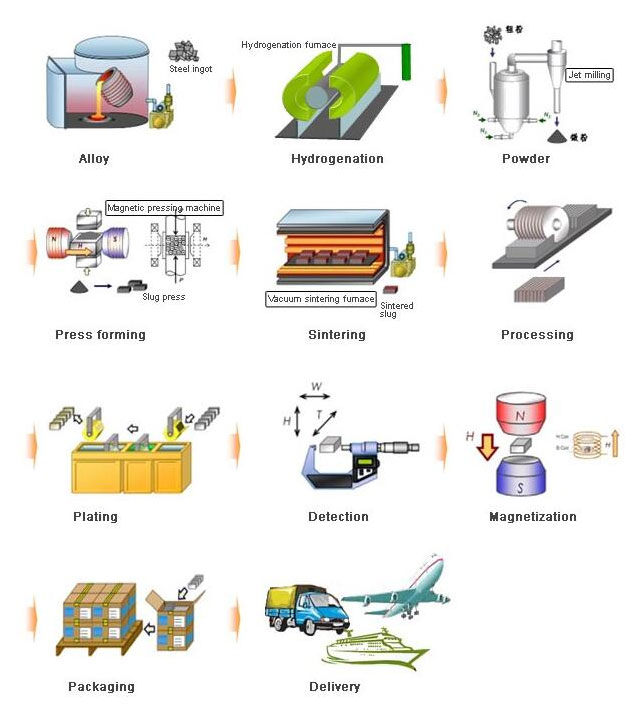NdFeB Magnets Materials
Introduction :Neodymium Magnets, also known as NdFeB, NIB, or Neo magnets, are the most widely-used type of rare earth magnets. It is the strongest type of permanent magnet made from an alloy of Neodymium, Iron, and Boron with the Nd2Fe14B tetragonal crystalline structure. It has replaced other types of magnets in many applications in modern products that require strong permanent magnets, such as motors in cordless tools, hard disk drives, and magnetic fasteners.
Sintering NdFeB Magnets:
physical properties of Sintering NdFeB Magnets
|
Parameter |
unit |
Parameter range |
|
Curie temperature |
℃ |
320-395 |
|
Maximum working temperature |
℃ |
70-250 |
|
Electrical resistivity |
KΩ.cm |
120-160 |
|
Thermal conductivity |
W/M.C |
7.0-10 |
|
Hardness |
HV |
560-650 |
|
Density |
G/Cm3 |
7.4-7.7 |
|
Relative Recoil Permeability |
|
1.02-1.08 |
|
Saturation Magnetization |
KOe |
30-40 |
|
Temperature Coefficient of Remanence |
%/℃(20℃-250℃ |
-(0.08-0.12) |
|
Temperature Coefficient of iHc |
%/℃(20℃-250℃ |
-(0.34-0.75) |
|
Compression Strength |
N/Mm2 |
1000-1300 |
|
Flexural Strength |
N/Mm2 |
250-400 |
|
Young modulus |
KN/Mm2 |
150-160 |
|
Elongation |
% |
~0 |
MAGNETIC CHARACTERISTICS OF SINTERED NdFeb
Production Process of Sintering NdFeB Magnets
|
GRADE
|
(Br)
|
(bHc)
|
(iHc)
|
(BH)max
|
Tw ℃
|
|
T
|
KGs
|
KA/m
|
KOe
|
KA/m
|
KOe
|
KJ/m3
|
MGOe
|
|
N35
|
1.18-1.23
|
11.8-12.3
|
≥868
|
≥10.9
|
≥955
|
≥12
|
263-287
|
33-36
|
≤80
|
|
N38
|
1.22-1.28
|
12.2-12.8
|
≥899
|
≥11.3
|
≥955
|
≥12
|
287-310
|
36-39
|
≤80
|
|
N40
|
1.26-1.31
|
12.6-13.1
|
≥923
|
≥11.6
|
≥955
|
≥12
|
302-326
|
38-41
|
≤80
|
|
N42
|
1.28-1.34
|
12.8-13.4
|
≥923
|
≥11.6
|
≥955
|
≥12
|
318-342
|
40-43
|
≤80
|
|
N45
|
1.32-1.37
|
13.2-13.7
|
≥876
|
≥11.0
|
≥955
|
≥12
|
342-366
|
43-46
|
≤80
|
|
N48
|
1.36-1.42
|
13.6-14.2
|
≥836
|
≥10.5
|
≥876
|
≥11
|
358-390
|
45-48
|
≤80
|
|
N50
|
1.39-1.45
|
13.9-14.5
|
≥836
|
≥10.5
|
≥876
|
≥11
|
374-406
|
48-51
|
≤80
|
|
N52
|
1.42-1.48
|
14.2-14.8
|
≥796
|
≥10.0
|
≥876
|
≥11
|
390-422
|
49-53
|
≤80
|
|
N35M
|
1.18-1.23
|
11.8-12.3
|
≥868
|
≥10.9
|
≥1114
|
≥14
|
263-287
|
33-36
|
≤100
|
|
N38M
|
1.22-1.28
|
12.2-12.8
|
≥899
|
≥11.3
|
≥1114
|
≥14
|
287-310
|
36-39
|
≤100
|
|
N40M
|
1.26-1.31
|
12.6-13.1
|
≥923
|
≥11.6
|
≥1114
|
≥14
|
302-326
|
38-41
|
≤100
|
|
N42M
|
1.28-1.34
|
12.8-13.4
|
≥923
|
≥11.6
|
≥1114
|
≥14
|
318-342
|
40-43
|
≤100
|
|
N45M
|
1.34-1.39
|
13.4-13.9
|
≥876
|
≥11.0
|
≥1114
|
≥14
|
342-366
|
43-46
|
≤100
|
|
N48M
|
1.36-1.42
|
13.6-14.2
|
≥876
|
≥11.0
|
≥1114
|
≥14
|
366-390
|
46-49
|
≤100
|
|
N35H
|
1.18-1.23
|
11.8-12.3
|
≥868
|
≥10.9
|
≥1353
|
≥17
|
263-287
|
33-36
|
≤120
|
|
N38H
|
1.22-1.28
|
12.2-12.8
|
≥899
|
≥11.3
|
≥1353
|
≥17
|
287-310
|
36-39
|
≤120
|
|
N40H
|
1.26-1.31
|
12.6-13.1
|
≥923
|
≥11.6
|
≥1353
|
≥17
|
302-326
|
38-41
|
≤120
|
|
N42H
|
1.28-1.34
|
12.8-13.4
|
≥923
|
≥11.6
|
≥1353
|
≥17
|
318-342
|
40-43
|
≤120
|
|
N45H
|
1.33-1.39
|
13.3-13.9
|
≥923
|
≥11.6
|
≥1353
|
≥17
|
342-366
|
43-46
|
≤120
|
|
N48H
|
1.36-1.42
|
13.6-14.2
|
≥923
|
≥11.6
|
≥1274
|
≥16
|
366-390
|
46-49
|
≤120
|
|
N33SH
|
1.14-1.19
|
11.4-11.9
|
≥836
|
≥10.5
|
≥1592
|
≥20
|
247-270
|
31-34
|
≤150
|
|
N35SH
|
1.18-1.23
|
11.8-12.3
|
≥868
|
≥10.9
|
≥1592
|
≥20
|
263-287
|
33-36
|
≤150
|
|
N38SH
|
1.22-1.28
|
12.2-12.8
|
≥899
|
≥11.3
|
≥1592
|
≥20
|
287-310
|
36-39
|
≤150
|
|
N40SH
|
1.26-1.31
|
12.6-13.1
|
≥923
|
≥11.6
|
≥1592
|
≥20
|
302-326
|
38-41
|
≤150
|
|
N42SH
|
1.28-1.34
|
12.8-13.4
|
≥923
|
≥11.6
|
≥1592
|
≥20
|
318-342
|
40-43
|
≤150
|
|
N45SH
|
1.33-1.39
|
13.3-13.9
|
≥923
|
≥11.6
|
≥1592
|
≥20
|
342-366
|
43-46
|
≤150
|
|
N28UH
|
1.03-1.09
|
10.3-10.9
|
≥780
|
≥9.80
|
≥1990
|
≥25
|
207-231
|
26-29
|
≤180
|
|
N30UH
|
1.09-1.14
|
10.9-11.4
|
≥812
|
≥10.2
|
≥1990
|
≥25
|
223-247
|
28-31
|
≤180
|
|
N33UH
|
1.13-1.17
|
11.3-11.7
|
≥852
|
≥10.7
|
≥1990
|
≥25
|
247-263
|
31-33
|
≤180
|
|
N35UH
|
1.18-1.22
|
11.8-12.2
|
≥868
|
≥10.9
|
≥1990
|
≥25
|
263-287
|
33-36
|
≤180
|
|
N38UH
|
1.22-1.27
|
12.2-12.7
|
≥899
|
≥11.3
|
≥1990
|
≥25
|
287-310
|
36-39
|
≤180
|
|
N28EH
|
1.03-1.09
|
10.3-10.9
|
≥780
|
≥9.80
|
≥2388
|
≥30
|
207-231
|
26-29
|
≤200
|
|
N30EH
|
1.08-1.13
|
10.8-11.3
|
≥812
|
≥10.2
|
≥2388
|
≥30
|
223-247
|
28-31
|
≤200
|
|
N33EH
|
1.13-1.17
|
11.3-11.7
|
≥852
|
≥10.7
|
≥2388
|
≥30
|
247-263
|
31-33
|
≤200
|
|
N35EH
|
1.18-1.22
|
11.8-12.2
|
≥868
|
≥10.9
|
≥2388
|
≥30
|
263-287
|
33-36
|
≤200
|
|
N28AH
|
1.03-1.09
|
10.3-10.9
|
≥780
|
≥9.80
|
≥2786
|
≥35
|
207-231
|
26-29
|
≤220
|
|
N30AH
|
1.08-1.13
|
10.8-11.3
|
≥812
|
≥10.2
|
≥2786
|
≥35
|
223-247
|
28-31
|
≤220
|

Bonded NdFeB Magnets:
Physical properties of Bonded NdFeB Magnets
|
Parameter |
unit |
Injection bonded ferrite magnet |
Bonded NiFeB magnet |
|
PBF-10 |
PBF-11 |
PBF-13 |
PBF-15P |
BN-6 |
PBN-8P |
BN-10 |
PBN-12 |
PBN-8H |
|
Curie temperature |
℃ |
450 |
310 |
310 |
310 |
310 |
310 |
|
Maximum working temperature |
℃ |
120 |
140 |
140 |
110 |
130 |
150 |
|
Density |
g/cm3 |
3.4-3.7 |
5.8-6.2 |
5.8-6.2 |
5.8-6.2 |
6.2-6.4 |
5.8-6.2 |
|
Recoil Permeability |
urec |
1.3 |
1.15 |
1.15 |
1.22 |
1.22 |
1.15 |
|
Saturation magnetization |
kOe |
10 |
>25 |
>25 |
>25 |
>25 |
>40 |
|
kA/m |
800 |
>=2000 |
>=2000 |
>=2000 |
>=2000 |
>=2000 |
|
Temperature Coefficient of Br |
%/℃ |
-0.2 |
-0.13 |
-0.13 |
-0.07~ |
-0.13 |
-0.07~ |
|
-0.15 |
-0.15 |
Size Range of Bonded NdFeB Magnets
|
Shape |
|
|
Grade |
Range |
|
Dic |
Dic |
 |
N42 |
D<=150 H<=60 mm B/H<=20 |
|
Radial Dic |
 |
42H |
|
N52 |
D<=80 H<=60 mm B/H<=20 |
|
Block |
 |
N42 |
L<=200 mm |
|
42SH |
W<=80 mm |
|
N50 |
L/W<=20, L/H<=20 |
|
N52 |
H<=80 mm |
|
Ring |
Axial ring |
 |
N42 |
|
|
D<=150 mm d>=1 mm |
|
(D-d)/2 >-=1.4 mm, d/D <=0.8 |
|
D/35<= H<=1.5 mm, H<=60 mm |
|
Radial ring |
 |
|
|
D<=150 mm d>=1 mm |
|
(D-d)/2 >-=1.4 mm, d/D <=0.8 |
|
D/35<= H<=1.5 mm, H<=60 mm |
|
|
|
Arc |
Tile |
 |
N42 |
|
|
L<=200 mm W<=80, H<=80 |
|
1.5 mm <= T <= 60 mm |
|
L/W<= 10, L/H<= 10 ,α<=180 |
|
Tile |
 |
|
|
|
N42SH |
W<=150 , H<=80 |
|
1mm <= T <= 60 mm |
|
W/H<= 5 mm, W/T<= 30mm |
|
|
|
Bread shape |
 |
N50 |
|
|
|
L<=200 mm |
|
|
W<=80 mm |
|
|
L/W<=20, L/H<=20 |
|
N52 |
H<=80 mm |
|
|
|
Sphere |
|
|
N42 |
|
|
Countersunk |
|
|
N42 |
|
|
N52 |
Neodymium Magnet Surface Treatments
1. Painting, coating, or plating is generally recommended for NdFeB.
2. Neo magnets can also be plated using ion vacuum deposition (IVD) techniques. This specialty plating is very controllable for thickness and has excellent adhesion to the material.
3. Nickel, zinc, or tin plating provides good corrosion resistance for NdFeB magnets, though longer lead times or higher volumes may be required for these.
4. Organic coatings exhibits good corrosion resistance characteristics, it is successfully developed for NdFeB. For especially harsh environments, it may be advisable to use a combination of coating techniques, or to encapsulate the material in a sealed housing.
Special Remarks
1. NdFeB powder is very fine and when dry can ignite spontaneously, special care must be taken when handling NdFeB powder.
2. NdFeB magnets are very powerful, special care must be taken in handling these magnets to avoid injuries.
3. NdFeB magnets are susceptible to corrosion.


 Data sheet
Data sheet

 Sintering NdFeB Magnets Curves Diagram
Sintering NdFeB Magnets Curves Diagram






